
International Journal of Marine Science, 2017, Vol.7, No.31, 297-307
297
Research Article Open Access
The Isolation of Metabolite Compounds from Seaweed (
Halimeda gracillis
) in
the Waters of Teluk Lampung as a Source of Antibacterial Compounds
Muhammad Hendri
1
,
J.S. Darmanto
2
, Budi Prayitno
2
, Ocky Karna Radjasa
3
, Elvita
4
1 Department of Marine Science, FMIPA Sriwijaya University, Palembang 30662, South Sumatera, Indonesia
2 Jurusan Teknologi Hasil Perikanan FPIK Universitas Diponegoro, Indonesia
3 Department of Marine Science, Diponegoro University, Semarang 50275, Indonesia
4 Department of Chemist, FMIPA Sriiwijaya University, Indonesia
Corresponding author email
International Journal of Marine Science, 2017, Vol.7, No.31 doi
Received: 14 Jul., 2017
Accepted: 07 Aug., 2017
Published: 11 Aug., 2017
Copyright © 2017
Hendri et al., This is an open access article published under the terms of the Creative Commons Attribution License, which permits
unrestricted use, distribution, and reproduction in any medium, provided the original work is properly cited.
Preferred citation for this article
:
Hendri M, Darmanto J.S, Prayitno B, Radjasa O.K, and Elvita, 2017, The isolation of metabolite compounds from seaweed (
Halimeda gracillis
) in the waters of
Teluk Lampung as a source of antibacterial compounds, International Journal of Marine Science, 7(31): 297-307 (doi
Abstract
The isolation of secondary metabolites of seaweed
Halimeda gracilis
was conducted. Isolation begins with 2 kg
macerated dried powder
Halimeda gracillis
in 8 L of n-hexane solvent followed by ethyl acetate and methanol for 3 days. The
solvent was filtered and followed by evaporation. Separation and purification of the isolated compounds were done by using
chromatography technique. Antibacterial activity was tested by the disc diffusion method with the bacteria
E. coli
,
S. disentriae
, and
B. subtilis
. Isolated compounds are in the form of white crystals. Based on the spectroscopy analysis data of UV, IR, 1H-NMR,
13C-NMR, HMQC, HMBC, and COSY, the pure compounds isolated are β-sitosterol from n-hexane extract and oleic acid from ethyl
acetate extract. Isolated compounds and n-hexane extracts showed non antibacterial active, while the ethyl acetate extract showed
weak antibacterial active on three test bacteria at a concentration of 200,000 ppm with clear zones of 9.47; 11.09; and 8.84 mm.
Keywords
Halimeda gracillis
; Antibacterial
Introduction
Seaweed is one of fishery commodities that have high economic value and become one of the sources of export
commodities and a source of income from non-oil sector. Seaweed contains many organic materials such as
polysaccharides, hormones, vitamins, minerals and bioactive compounds and is one of the plants producing
hydrocolloid materials (Anggadireja, 2006). Besides containing hydrocolloid materials as its primary component,
seaweed also contains secondary components that have the potential to be developed in various fields such as
pharmaceuticals, cosmetics, and other industrial purposes (Atmadja, 1991).
Currently, seaweed has been used as raw materials for industry. Some of the main ingredients produced by
seaweeds are jelly, carrageenan and alginate (Aslan, 1998). Some seaweed products are also widely used as food
ingredients, additives or adjuvants in the food industry, pharmaceuticals, cosmetics, textiles, paper, paint, and
others. In addition, the waste can also be used as fertilizer and animal or fish feed components. When viewed from
the benefits and usefulness, it is true that the seaweed in the future may be one of the commodity trade has bright
prospects for development, both to meet the needs of the domestic and export markets (Zatnika, 1985).
One of the potential that can provide economic added value to the seaweed ecosystem is its bioactive compounds
(Arifudin, 2001). Some types of seaweed that has the ability to produce bioactive compounds are Halimeda sp
with
Halimedatrial
and
Halimeda
Tetrasetat
compounds (Paul and Fenical, 1983a). These compounds allegedly
can be used as an antibacterial, antifungal, antifouling, anticancer, antiviral, and so on (Paul and Fenical, 1983b).
Some types of seaweed such as
Sargassum
sp. and
Turbinaria
sp. has been reported to have potential as bioactive
compounds that can be used in pharmacy and medicine fields. These compounds are secondary metabolites that
are used in defense systems, in order to survive and avoid interference from other organisms in the environment.
In addition to the defense, the compound has the capability of pharmacological activity that has the potential to be
used in the pharmaceutical field.


